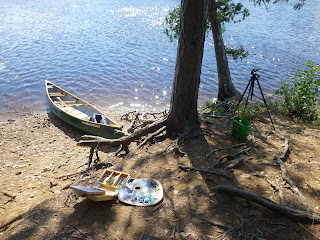 |
| #2898 "Dumoine Severe Backbuilding Anvils on the Southern Horizon" Oils on commercial stretched canvas 8 X 10 (inches). Started 3:30 pm Saturday, August 3rd, 2024 from very near N46.466881 W77.768433. |
The towering cumulus clouds to the south of John's Cabin were exploding into strong thunderstorms. The cumulonimbus clouds were potentially severe with back building anvils growing upwind into the prevailing southwesterly flow. I did not witness any "over-shooting" updrafts poking through the tropopause. The convection must be especially strong should the updraft possess so much energy that it explodes right into the stratosphere. Such thunderstorms demand respect and are best avoided. Modern radar and air traffic controllers guide the planes to vector around these dangerous storms.
 |
| It was still sunny on the Dumoine when #2898 was finished... There was a lot of weather but most would just recall that it was a beautiful day! |
The thunderstorms themselves are steered by the average wind through the most buoyant portions of the updraft. Severe thunderstorms that evolve into supercells actually create their own wind regime and tend to steer to the right of the mean flow as they evolve. There was a significant chance that these cells I observed were moving eastward along the west-to-east warm front with each of the five thunderstorms I observed dropping their load of rain along similar paths.
Climate change and a warming atmosphere allow 7 to 8 percent more water vapour to be held therein with each degree Celsius increase. This additional moisture in the atmosphere is increased fuel for convection which also converts into heavier precipitation events. Greenhouse Earth has witnessed an increasing number of these catastrophic severe rain events.
Most of the time over the sparse population of Canada these torrential, convective training events occur over remote locations with nil impact on infrastructure. The probability of severe training thunderstorm events has increased with climate change and a warming climate along with Canada's increasing population and the associated infrastructure. The July 21, 2023, Halifax Record Rain Event is an example of such an event.
The vigorous towering cumulus that developed between John's Cabin and the bases of the thunderstorms were triggered by outflow boundaries from the strong convection. The heavy rainfall with those storms draws air down to the ground along with the extreme precipitation. This air spreads outward from the heavy rain. Those outflowing boundaries interact with the undisturbed winds in the atmosphere creating areas where the air converges. That convergent air must go up and in an unstable and moist environment, those updrafts create the fresh convection as I included in my painting.
There were still some gravity waves in the sky. I strongly suspect those were at the tropopause which was like a stable "bed sheet" being shaken by the thunderstorms.
I had been painting since 6 am and it was pushing 5 pm when I finished this final weather observation of the day. I was just a bit tired and retired to the fire pit at John's Cabin to visit with the other participants of CPAWS DRAW 2024.
 |
| When asked, I do my best to explain the lessons displayed in the sky... I do not intend to be dull or boring but it just comes naturally. I try to help if I can. |
For this and much more art, click on Pixels or go straight to the Collections. Here is the new Wet Paint 2024 Collection. Here is the link to the CPAWS DRAW Collection
Warmest regards and keep your paddle in the water,
Phil Chadwick






No comments:
Post a Comment